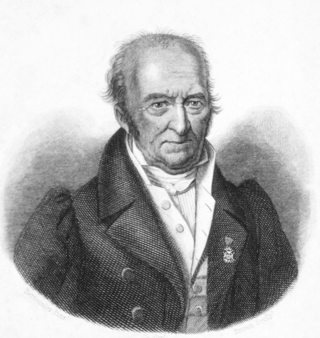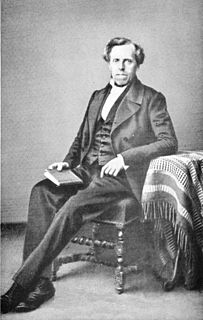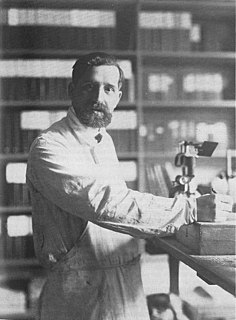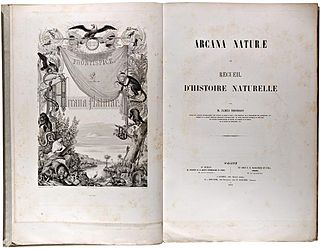Related Research Articles
Family is one of the eight major hierarchical taxonomic ranks in Linnaean taxonomy. It is classified between order and genus. A family may be divided into subfamilies, which are intermediate ranks between the ranks of family and genus. The official family names are Latin in origin; however, popular names are often used: for example, walnut trees and hickory trees belong to the family Juglandaceae, but that family is commonly referred to as the "walnut family".

René Antoine Ferchault de Réaumur was a French entomologist and writer who contributed to many different fields, especially the study of insects. He introduced the Réaumur temperature scale.

Jean-Henri Casimir Fabre was a French naturalist, entomologist, and author known for the lively style of his popular books on the lives of insects.

Pierre André Latreille was a French zoologist, specialising in arthropods. Having trained as a Roman Catholic priest before the French Revolution, Latreille was imprisoned, and only regained his freedom after recognising a rare beetle species he found in the prison, Necrobia ruficollis.
Abbé Pierre Joseph Bonnaterre was a French zoologist who contributed sections on cetaceans, mammals, birds, reptiles, amphibians, fish, and insects to the Tableau encyclopédique et méthodique. He is also notable as the first scientist to study the feral child Victor of Aveyron.

Jules Pierre Rambur was a French entomologist.

Achille Guenée was a French lawyer and entomologist.

Amédée Louis Michel le Peletier, comte de Saint-Fargeau, also spelled Lepeletier or Lepelletier, was a French entomologist, and specialist in the Hymenoptera.

Pierre-Justin-Marie Macquart was a French entomologist specialising in the study of Diptera. He worked on world species as well as European and described many new species.

Victor Ivanovich Motschulsky was a Russian entomologist mainly interested in beetles.

Jean Guillaume Audinet-Serville was a French entomologist, born on 11 November 1775 in Paris. He died on 27 March 1858 in La Ferté-sous-Jouarre.

Carnidae, also known as Bird flies or Filth flies, is a family of flies (Diptera). There are 6 genera, containing about 93 species worldwide.

Heteroneura is a natural group in the insect order Lepidoptera that comprises over 99% of all butterflies and moths. This is the sister group of the infraorder Exoporia, and is characterised by wing venation which is not similar or homoneurous in both pairs of wings. Though basal groups within the Heteroneura cannot be identified with much confidence, one major subgroup is the leaf-mining Nepticuloidea. Species in this subgroup include some of the smallest lepidoterans identified.

Eugene Séguy was a French entomologist and artist who specialised in Diptera. He held a chair of entomology at the Muséum national d'histoire naturelle in Paris from 1956 to 1960. He is also known for establishing the Diptera section at that museum. This entomologist is often confused with a French artist with a similar name: Émile-Allain Séguy (1877–1951). The latter is known for his pochoir artworks representing plants and insects.

The Great French Wine Blight was a severe blight of the mid-19th century that destroyed many of the vineyards in France and laid waste to the wine industry. It was caused by an aphid that originated in North America and was carried across the Atlantic in the late 1850s. The actual genus of the aphid is still debated, although it is largely considered to have been a species of Daktulosphaira vitifoliae, commonly known as grape phylloxera. While France is considered to have been worst affected, the blight also did a great deal of damage to vineyards in other European countries.

The Milesiini is a large and diverse tribe of hoverflies. They mimic wasps or hornets.

James Livingston Thomson was an American entomologist who specialised in Coleoptera.
The Lipotrophidae are a family of parasitic alveolates in the phylum Apicomplexa. Species in this family infect insects.
Lipotropha is a genus of parasitic alveolates of the phylum Apicomplexa.

Desmond W. Helmore is a New Zealand artist and illustrator, known both for his fine art and for his scientific work depicting insects, not least illustrating the New Zealand Arthropod Collection. One of the country's most noted and prolific biological illustrators, over 1000 of his illustrations of insects were published in research papers from 1976 to 2006.
References
- Lacordaire, T. 1863: Histoire Naturelle des Insectes. Genera des Coléoptères ou exposé méthodique et critique de tous les genres proposés jusqu'ici dans cet ordre d'insectes. Vol.: 6. Roret. Paris: 637 pp.